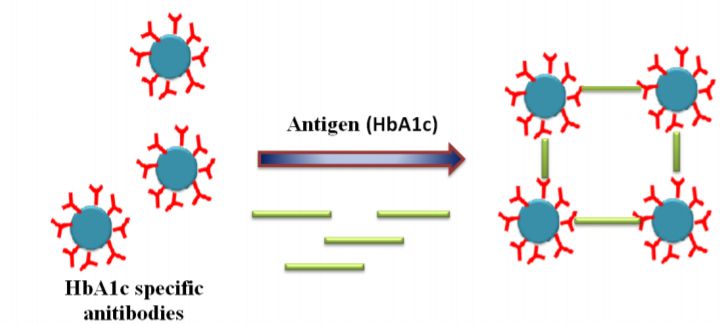Diabetes mellitus(DM)is a chronic disease caused by deficiency or diminished effectiveness of endogenous insulin. It is characterised by hyperglycaemia, deranged metabolism and sequelae predominantly affecting the vasculature. The most common types include type 1 and type 2 DM.

DM represents a major health problem of the 21st century, causing severe long-term damage to the cardiovascular and nervous system as well as eyes and kidneys. The World Health Organization (WHO) estimated 1.6 million deaths each year to be directly caused by diabetes [1].

Most cases (90%) of DM are type 2, which arises from defects in insulin action leading to insulin resistance, often combined with defects in insulin secretion. Circulatory insulin levels therefore may be normal or raised, but it cannot be used effectively. This subtype is predominant in middle-aged overweight patients with a sedentary lifestyle. In 2011 the WHO advocated the use of HbA1c for the diagnosis of type 2 DM and in 2012 UK guidance suit [2, 3].
The term HbA1c refers to glycated haemoglobin. It develops when haemoglobin, a protein within red blood cells that carries oxygen throughout your body, joins with glucose in the blood, becoming “glycated”. HbA1c test tells you your average level of blood sugar over the past 2 to 3 months.
Most POCT devices for HbA1c use a drop of capillary or venous whole blood. Following application to the test cartridge, the sample is analysed within a few minutes using methods based on either differences in structure or charge of the glycated vs non-glycated haemoglobin.
Ion-exchange chromatography: Haemoglobin species (HbA1c and HbA0) are separated based on the difference in isoelectric point, by employing differences in ionic interactions between the haemoglobin in the blood sample and the cation exchange groups on the column resin surface. HPLC is based on ion-exchange chromatography technology, which is a gold standard in detecting HbA1c.

Immunoassay: The immunoassay method uses antibodies which bind to the N-terminal glycated tetrapeptide or hexapeptide group of the HbA1c, forming immunocomplexes which can be detected and measured using a turbidimeter or a nephelometer.

Affinity chromatography: Affinity chromatography is a separation technique based on structural differences between glycated vs non-glycated haemoglobin which utilises m-aminophenylboronic acid and its specific interactions with the glucose adduct of glycated haemoglobin.

Enzymatic assay: Enzymatic quantification of HbA1c is based on cleavage of the beta chain of haemoglobin by specific proteases to liberate peptides, which then further react to produce a measurable signal (4).


HbA1c in diagnosis
HbA1c can indicate people with prediabetes or diabetes as follows:

How often do we need to take a HbA1c test?
Everyone with diabetes mellitus should be offered a HbA1c test at least once a year. Some people may have an HbA1c test more often. This may be more likely if you have recently had your medication changed or your health team are otherwise wishing to monitor your diabetes control more than once a year[6].
Although HbA1c level alone does not predict diabetes complications, good control is known to lower the risk of complications.
References:
[1] John WG. Use of HbA1c in the diagnosis of diabetes mellitus in the UK. The implementation of World Health Organization guidance 2011. Diabet Med. 2012;29(11):1350-7.
[2] Organization WH. Use of Glycated Haemoglobin (HbA1c) in the Diagnosis of Diabetes.
[3] English E, Milosovich ET, John WG. In vitro determination of hemoglobin A1c for diabetes
[4] diagnosis and management: technology update. Pathology and Laboratory Medicine International. 2014;6:21-31.